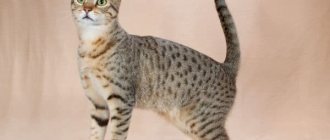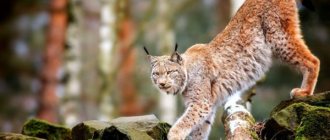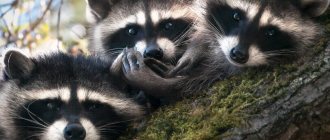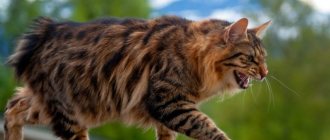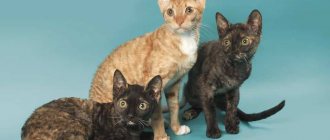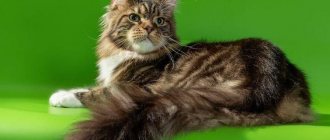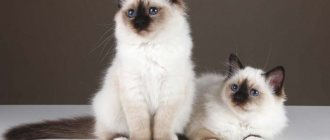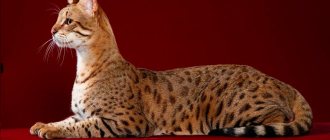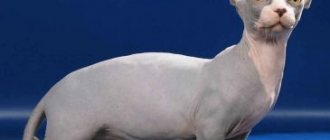The feline family is not only about cute furry animals that purr and rub against their owner's legs. Even domestic cats can reach speeds of up to 40 km/h over short distances, and wild cats are among the fastest animals on the planet. Moreover, if we consider that they are all predators, this means they are also among the most dangerous.
Dune cat
The sand cat is the smallest representative of wild cats, and therefore is often endangered by other predators. Capable of chasing prey at a speed of 40 km/h for 10 km.
Egyptian Mau
Although the Egyptian Mau has long been domesticated, the wild nature of the cat still takes over. From the time when her ancestors had to hunt for survival, Mau learned to run at a speed of 58 km/h.
Leopard
For him, high speed is not particularly important, since he does not hunt on the ground. This spotted wild cat prefers to watch for prey, hiding in the foliage of trees, and overtake it with one sharp jump. He has strong muscular legs, and his running speed can reach 60 km/h.
Tiger
A very large cat, capable of chasing prey at speeds of 60 km/h. But a weight of more than 300 kg and a 3-meter body length often interfere with successful hunting.
Puma
Like the lion, its close relative is large in size, but is capable of maintaining a speed of 75 km/h. This gives the puma an advantage during hunting, but its large dimensions do not allow it to maintain speed for a long time.
Snow Leopard
The handsome snow leopard can only be found high in the mountains. He not only runs fast, but also jumps. The length of his jump can be 6 meters and the height - 3 meters. In terms of running speed, the leopard is not inferior to the lion, while the animal’s long tail acts as a steering wheel and helps to turn in different directions.
a lion
The king of beasts is a fairly large animal with a body weight of more than 2 centners. Therefore, it is difficult for him to maintain high speed over long distances. At a speed of about 80 km/hour, a lion can run no more than 20 meters. When hunting, this predator prefers to lie in wait for its prey and pounce on it.
Panther
The panther is not only fast, but also the most dexterous and dangerous predator.
This wild cat is unusually graceful and, unlike its counterparts, hunts near human settlements. The black beauty is capable of running at a speed of 88 km/h and is particularly bloodthirsty. The objects of her hunt can be not only animals, but also humans.
Jaguar
This animal can move at a speed of 90 km/hour. Jaguars are large. The body, without a tail, can reach a length of more than 2 meters. Because of their size, it is quite difficult for them to pursue prey at high speed for a long time.
Cheetah
Considered the fastest animal on Earth. A wild cat has a powerful, muscular body without an ounce of excess fat. The weight of a cheetah is 70 kg, and the speed that the animal develops exceeds 110 km/h.
The predator will not sit in ambush and guard the prey. The cheetah needs a few tugs and the prey will be in its claws. Just two seconds are enough for this “savage” to develop lightning speed, and the length of the jump can reach 8 meters.
Siamese cat
Siamese cats are playful, active, sometimes noisy and quite demanding. Their cheerful intelligence allows them to do many complex things, such as turning on faucets, switching lights, and opening cabinets. To keep her entertained, you'll have to give her puzzle toys, exercise, and maybe even agility training.
Egyptian Mau
The fastest representatives of domestic cats are considered to be the Egyptian Mau (“Mau” means cat). The maximum record of these miniature darlings is acceleration to 58 km/h (over short distances). All zoologists claim that if these animals had larger dimensions, they could well compete with the cheetah for the title of the fastest animal on the planet.
The fastest breeds of domestic cats
Most domestic cats run faster than humans. Some of them are capable of reaching speeds of up to 45 km/h.
Most often, running speed depends on the body features inherent in a particular breed. Fast domestic cat breeds include:
Oriental
The Oriental is an elegant cat breed devoted to one person. To be completely happy, they need races, physical exercise and active games. If an Oriental is kept indoors, it will have fun making a mess.
Siamese cat
The Siamese cat is always active and can make too much noise. Her restless temperament allows her to play pranks in several places at the same time.
It is important for the owner to know that Siamese dogs benefit from physical exercises for speed and agility.
Manx
Manx is one of the most ancient breeds. They differ from their counterparts by having a short or completely absent tail. Cats of this breed show excellent results in agility and speed.
Ocicat
The Ocicat is a muscular descendant of Abyssinians, Siamese and American Shorthairs. In addition to his athletic build, he is known for his speed and agility. Cats of this breed are very sociable and attached to their owner.
Savannah
Savannah is a close relative of the wild serval. Cats of this breed are very smart, curious and energetic. From their wild ancestors they inherited the ability not only to run fast, but also to climb to great heights.
Bengal
Bengal will never get bored and will not let its owner do so. An extremely active breed, and also a keen climber. If your Bengal cat is out of sight, you should pay attention to the top of the room. She will definitely be there.
Somali cat
The Somali cat is a long-haired version of the Abyssinian. It has a muscular body and well-developed limbs. Shows high ability to train and perform tricks.
Ragdoll, 5-9 kg
The Ragdoll is a unique breed. Kittens are born white and are very friendly with their owners. One can say even more - the owner for this breed is the center of the Universe. You always want to pet a beauty with luxurious fur; she responds to affection with a kind disposition and tenderness.
Those who often have scandals in their family should give up the idea of getting a Ragdoll, because the animal takes everything to heart, and it may even become depressed. The same applies to people who are absent all the time - the cat begins to feel sad and depressed if it is alone for a long time.
These wonderful cats with bright eyes do not require much, the most important thing is that the owner is nearby and there are no scandals in the house.
Tiger
The tiger has also long been on the list of the fastest representatives among predatory cats. At short distances, it is capable of reaching speeds of up to 60 km/h. Just imagine that in pursuit of a victim they will be able to jump 5-6 meters in length (and in height, by the way, too).
But, even despite these physical abilities, not every tiger hunt is successful. These cats are very massive, their weight can increase up to 300 kg, and their body length (excluding the tail) can vary up to three meters. That is why, despite their physical dominance, they are significantly inferior to the cheetah in speed.
Nibelung
The menacing gaze of the Nibelung
Representatives of the breed are mistakenly called long-haired Russian Blues. The latter are the progenitors of the Nibelungs, but this breed is considered independent.
The first Nibelung kittens were born in America. Cora Cobb discovered two kittens with long hair in the litter. The woman had to cull them, but the babies’ fur surprised Cora so much that she decided to create a new breed. Later, when the kittens grew up, Cora mated them with each other and got long-haired kittens. And then, in 1987, the Nibelungs were recognized as an independent breed.
Representatives of the breed are large and powerful individuals. Thanks to their long hair, Nibelungs appear much larger than they are. These cats are hardy, excellent hunters, and unobtrusive in communication. An ideal place to live would be a private home, where animals can hunt and burn off energy while frolicking around the property. Nibelungs are active, sort of “energizers” who love to run and jump.
The breed is bred in Russia by the Severnaya Zvezda nursery (St. Petersburg).
Sixth place – Puma
The predator runs very quickly over short distances. The animal is capable of reaching speeds of up to 75 km/h. That is, a cougar can even catch up with a car that is not going too fast.
In the United States of America, the cougar is commonly called the “mountain lion.” The name is associated with the animal's habitat. The predator can be found not only in forests, but also in the mountains. Moreover, the puma is found even in the jungle and swamps.
Differs in large sizes. Together with the tail, the body reaches 2 meters in length. At the same time, the weight is not too large - from 50 to 100 kg. Much depends on gender and individual characteristics. Due to its well-developed muscles and light weight, the Puma is able to run quickly and hunt deftly.
Selkirk Rex
Selkirk colors can vary
The first cat was brought to Russia in 2004, and later a “girlfriend” joined him. The animals became the progenitors of the Selkirk Rex in the Russian Federation.
The roots of the breed begin in America, in a shelter for homeless animals. The cat gave birth to kittens, one of which turned out to have unusual fur. The shelter employee decided to keep the baby for herself, and later showed it to her friend, a breeder of Persian cats. She was delighted when the cat grew up and took her for herself.
Later, the woman bred the kitty with her Persian cat. In a litter of five kittens, three had an unusual coat structure. Thus began the breeding of a new breed, named after the breeder’s father – Selkirk.
Sheep cats - that's what they were called for their curly fur. Selkirks are very powerful, with good bones. Some cats reach 10-12 kg, the average weight is 8 kg. Cats are not much smaller - from 5 to 7 kg.
Among the Selkirks, there are both curly and straight-haired representatives. The latter are called Selkirk Straight.
Representatives of the breed very sensitively sense the mood of the owner. If he is not in the mood, the animals simply will not impose themselves. Otherwise, the Selkirks will not deny themselves the pleasure of lying on their master’s lap and singing a simple song.
By the way, “sheep” are able to learn various tricks, which they then willingly demonstrate to everyone.
Savannah
The Savannah is a cross between a domestic cat and a Serval, a medium-sized African cat with large ears. Savannah will climb as high as she can, and her long body and legs allow her to reach not only great heights, but also great speeds. The breed is also known for its curiosity, keen intelligence and energy.
Puma
The puma (or mountain lion) consistently occupies sixth position in the world top of the fastest cats. These predators reach speeds of up to 75 km/h over short distances.
These large animals reach two meters in length (including tail). The weight of these cats reaches 100 kg. A well-developed muscular system and low weight contribute to the speed and agility of mountain lions. They can accelerate to 75 km/h.
Females are smaller in size than males. But, at the same time, they are not inferior to them in agility and speed.
La Perm
Grace and nobility
The breed was officially registered in 1995. And it all started in the early 80s of the last century, in America. An ordinary cat gave birth to kittens, one of the babies turned out to be completely bald. Two weeks passed, the hairless cat child was covered with curly fur.
The owner of Curly, as the cat was named, was concerned about such a strange type of fur. When the cat grew up and began to bear offspring, the babies inherited her curly hair. Owner Linda Koehl decided that the time had come to breed a new breed, she involved several breeders she knew, and things got going.
La Perm is a breed with unusually shaped curls. Representatives of the breed have a striking appearance, large and muscular. The weight of a cat can reach 11 kg, smaller cats – up to 7 kg. At the same time, the animal's body consists of muscles instead of fat.
Curly-haired cats have a calm, affectionate disposition. They need the owner's attention like air. In America, Great Britain and France, the breed is common; its breeding has been practiced for a long time and firmly. In Russia you can only buy a kitten in one nursery. The price starts from 1500 euros.
Bengal cat
Bengals love to play and enjoy any activity. They are also very demanding of your attention and will do whatever it takes to get it. Your Bengal will easily find a way to climb to the highest point in your house, he will enjoy games and activities, and he will definitely not sit on your lap all day.
The fastest cats in the world
Wild cats are fast and agile animals that are excellent hunters. Even a domestic cat can run at a speed of 40 km per hour. The pet will not be able to cover a long distance at this pace. He will be able to make a tiny leap. Wild cats have greater endurance, so they are able to run at high speed for much longer.
When measuring indicators, the distance and time it takes the animal to cover the distance are taken into account. There are many cats in nature that are capable of running with incredibly high agility.
Causes of aggressiveness in cats
Cat rage can be triggered by several factors, the most common of which are:
- illness and poor health;
- fear of people;
- hunting instincts;
- self-defense;
- genetic predisposition.
Any cat is, first of all, a predator with its own needs and instincts, which can manifest themselves at any moment. This should always be remembered, especially if you decide to get a pet from the list of potentially dangerous and aggressive breeds.
Liked? Please rate the article!
You might be interested
The most terrible dog
What breed of cats to choose for an apartment
Rating of the most aggressive dogs
Do Sphynxes need mustaches?
The fastest cats
What helps the fastest cats run
Among purebred cats, the Egyptian Mau is considered the record holder for speed. He was lucky with the structure of his hind legs, which have leathery folds at the base. Due to them, while running, the step reserve and amplitude of movements increase, and therefore the speed increases.
The normal speed of cats (on average) is 13.5-13.8 km/h. If a cat moves at a leisurely trot, then it will barely overtake a walking person, and its speed will be about 8 km/h. Whereas the maximum speed of cats is 50 km/h.
Chausi, 6–12 kg
Chausie is included in the list of the most exotic and expensive breeds. A miniature copy of a wild cat can become a worthy companion and will fall into the soul of even the most avid dog lover.
Chausi miraculously combine sociability and independence, which additionally gives them charm. Unlike most cats, representatives of this interesting breed love water, so you shouldn’t be surprised if the cat willingly creates splashes in the bathroom - it makes her happy!
Chausie is an extravagant cat that is highly trainable due to its desire to learn something new and its developed intelligence.
Snow Leopard
This top is completed by the snow leopard. They are capable of jumping over a distance of 6-7 meters (the height of the jump reaches 3 meters). The leopard has short, but muscular and strong legs and a fairly long tail, which is necessary to maintain balance during a sprint. By the way, the maximum speed of this representative of the cat family can reach 80 km/h. The snow leopard is the highest mountain animal among all the inhabitants on the planet.
The first position in the ranking is still occupied by the cheetah. This spotted hunter is capable of reaching a speed of 112 km/h. in just 3 seconds. The maximum speed reaches 130 km/h. The length of one jump of this predatory cat can reach 7-8 meters. In addition, the cheetah is able to change the trajectory of its movement almost at lightning speed. That is why the victim has virtually no chance to escape the attack.
- Author: iarriba
Rate this article:
- 5
- 4
- 3
- 2
- 1
(36 votes, average: 3.9 out of 5)
Share with your friends!
Jaguar
The jaguar belongs to the genus panther. It lives in South and Central America, feeding on both small rodents and adult mammals. He can swim and climb trees. It spends its life alone, meeting other representatives of its species only during reproduction.
Jaguar
Some features of this predator:
- body weight - 60-90 kg;
- body length, not counting the tail, 1.1-1.8 meters;
- life expectancy is 10 years, in captivity - up to 25 years;
- the jaguar hunts at night and prefers to sleep during the day;
- the animal is listed in the Red Book.
The genus of panthers is distinguished by the fact that the spots on the skin of predators are unique, like human fingerprints.
MegaMix
Domestic cats run somewhat slower than homeless cats, for whom speed and lightning speed of reaction are a way of survival. But even at home, they need active movement, so even without visible danger, the cat likes to stretch its muscles, rushing from room to room. In such games, she seems to be chasing imaginary prey. The average speed of the animal, regardless of its habitat, is 13.86 m/s. Even the most unprepared cat runs much faster than a human thanks to a special running technique.
Maximum and average speed
| average speed | Maximum speed | |
| 13.86 m/s | 50 km/h | up to 58 km/h (home) |
In case of danger, she lunges, arches her back and makes jumps that exceed the length of her own body up to 6 times. The front and hind legs work in pairs. When jerking, the animal pushes off the surface with its hind legs, landing first on the front, then on the back pair of legs. When walking leisurely, a cat steps on the pads, but when running, the cat's claws extend outward, which provides better traction on the surface for effective pushing.
Features of running cats and cats of different breeds
Maine Coon cats use their fluffy tail, which has strong muscles at the base, to regulate speed. The bobtail cat breed cannot boast of a powerful tail, as this limb is practically absent. They develop high speed thanks to their high and strong hind legs. This variety is considered one of the most energetic cat breeds; the bobtail needs long active games and requires an equally active lifestyle of the owner.
The leader in terms of speed among domestic cats is the Egyptian Mau breed. At the base of their hind legs they have folds of skin in the form of small bags. The resulting step reserve allows the cat to have a particularly wide range of motion when running and, therefore, to run faster than its relatives from other breeds.
The cat is the victim, the cat is the hunter
Since cats do not occupy a dominant position in the food chain, in the wild they often find themselves in the role of prey and her life depends on how quickly she manages to escape. In its own hunt, this small predator usually focuses on surprise and dexterity of the paws, rather than speed. Having previously hidden and accurately calculated its death-carrying throw, a cat is able to catch a mouse or bird even in flight.
Speed is an advantage, but not an option
However, with all its sprinting qualities, which allow the cat to reach speeds of up to 50 km/h, the cat’s heart is not able to withstand prolonged stress. After a long run at high speed, the cat is forced to stop to normalize its body temperature and breathing. Therefore, when the pursuit is too long, the animal will have to give up. A cat driven by a pack of dogs is doomed to death if it has nowhere to hide.
In urban conditions, where there is not always a suitable tree to climb and avoid danger, these animals die more often than in rural areas.
Leopard
A leopard is a large cat, smaller than a tiger or lion. Lives in Africa, Asia, the Far East in Russia. Has spots all over the body. There are also black panthers that also have spots, but due to melanism they do not show through.
Leopard
Leopard Characteristics:
- weight in males is up to 80 kg, in females up to 65;
- body length, excluding the tail, 0.9-1.9 meters;
- life expectancy 12-15 years, in captivity – up to 23 years;
- Leopards climb trees and can swim and fish.
The population of these animals is steadily declining: five species are already listed in the Red Book, and the number of Far Eastern, or Amur, leopards is 60 individuals. This is due to the constant cutting down of trees in the main habitats, poaching and a decrease in the food supply.

